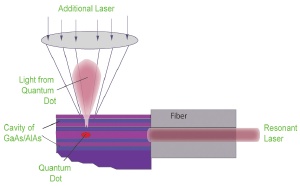Aug 19 2008
Researchers from the National Institute of Standards and Technology (NIST) and the Joint Quantum Institute (JQI), a collaborative center of the University of Maryland and NIST, have reported a new way to fine-tune the light coming from quantum dots by manipulating them with pairs of lasers. Their technique, published in Physical Review Letters,* could significantly improve quantum dots as a source of pairs of "entangled" photons, a property with important applications in quantum information technologies. The accomplishment could accelerate development of powerful advanced cryptography applications, projected to be a key 21st-century technology.
 Schematic of NIST-JQI experimental set up. Orienting the resonant laser at a right angle to the quantum dot light minimizes scattering.
Schematic of NIST-JQI experimental set up. Orienting the resonant laser at a right angle to the quantum dot light minimizes scattering.
Entangled photons are a peculiar consequence of quantum mechanics. Tricky to generate, they remain interconnected even when separated by large distances. Merely observing one instantaneously affects the properties of the other. The entanglement can be used in quantum communication to pass an encryption key that is by its nature completely secure, as any attempt to eavesdrop or intercept the key would be instantly detected. One goal of the NIST-JQI team is to develop quantum dots as a convenient source of entangled photons.
Quantum dots are nanoscale regions of a semiconductor material similar to the material in computer processors but with special properties due to their tiny dimensions. Though they can be composed of tens of thousands of atoms, quantum dots in many ways behave almost as if they were single atoms. Unfortunately, almost is not good enough when it comes to the fragile world of quantum cryptography and next-generation information technologies. When energized, a quantum dot emits photons, or “particles” of light, just as a solitary atom does. But imperfections in the shape of a quantum dot cause what should be overlapping energy levels to separate. This ruins the delicate balance of the ideal state required to emit entangled photons.
To overcome this problem, the NIST-JQI team uses lasers to precisely control the energy levels of quantum dots, just as physicists have been doing with actual single atoms since the mid-1970s and, much more recently, with the artificial quantum dot variety. With their customized set-up, which includes two lasers—one shining from above the quantum dot and the other illuminating it from the side—the researchers were able to manipulate energy states in a quantum dot and directly measure its emissions. By adjusting the intensity of the laser beams, they were able to correct for imperfection-caused variations and generate more ideal signals. In so doing, the team was the first to demonstrate that laser-tuned quantum dots can efficiently generate photons one at a time, as required for quantum cryptography and other applications.
While the device currently still requires quite cold temperatures and sits in a liquid helium bath, it is compact enough to fit in the palm of your hand—an elegant setup that could be eventually implemented in quantum cryptography applications.
* A. Muller, W. Fang, J. Lawall and G.S. Solomon. Emission spectrum of a dressed exciton-biexciton complex in semiconductor quantum dot. Physical Review Letters, 101, 027401 (2008), posted online July 11, 2008.
Media Contact: Mark Bello, [email protected], (301) 975-3776